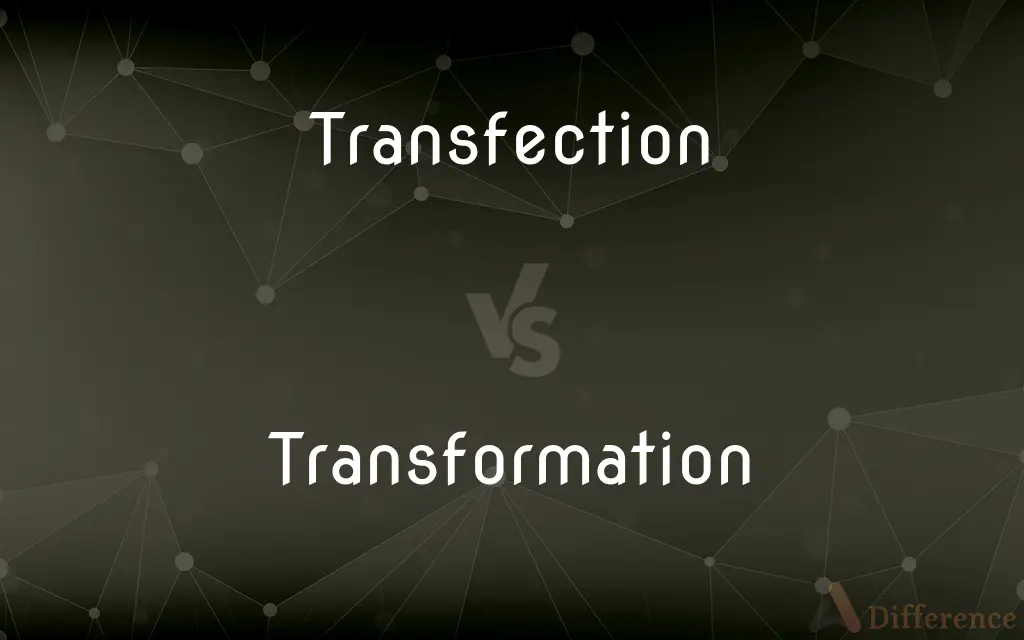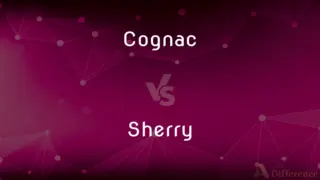Transfection vs. Transformation — What's the Difference?
Edited by Tayyaba Rehman — By Urooj Arif — Updated on March 15, 2024
Transfection involves introducing foreign nucleic acids into cells, often using chemical or physical methods. Transformation refers to the genetic alteration of a cell resulting from the direct uptake of exogenous genetic material.

Difference Between Transfection and Transformation
Table of Contents
ADVERTISEMENT
Key Differences
Transfection is a laboratory technique used to introduce foreign DNA or RNA into eukaryotic cells to study gene expression and function. Various methods, including lipofection, electroporation, and viral vectors, are employed to facilitate this process. Whereas transformation is a process by which foreign DNA is introduced into a cell, leading to genetic modification. This term is most often used in the context of bacteria, where cells take up free, foreign DNA from their surroundings, a natural competence in some species or induced in laboratory settings.
In transfection, the main objective often involves experimental manipulation of gene expression, protein function, or to create genetically modified cell lines for research. On the other hand, transformation can be a natural process for genetic diversity in bacteria or a tool in molecular biology to create genetically modified bacteria for cloning, protein production, or other research purposes.
The efficiency and methods of transfection can vary widely depending on the cell type, the size of the nucleic acid being introduced, and the specific technique used. Electroporation and chemical methods are common, but each has its own advantages and limitations. Transformation, while it can be artificially induced, also occurs naturally in some bacterial populations, allowing them to adapt and evolve by acquiring new genetic traits from their environment.
Transfection is generally not used to describe the introduction of DNA into bacterial cells; this is where the term transformation is specifically applied. Conversely, transformation in the context of eukaryotic organisms usually refers to the process of cancerous cell development, not the introduction of foreign DNA.
Both transfection and transformation are crucial in genetic engineering, biotechnology, and research fields, enabling scientists to study gene function, produce recombinant proteins, and develop new therapeutics. While the terms are related to the introduction of foreign genetic material into cells, their specific applications and contexts differ significantly.
ADVERTISEMENT
Comparison Chart
Definition
Introduction of foreign nucleic acids into eukaryotic cells.
Genetic alteration of a cell by uptake of foreign DNA, mainly in bacteria.
Primary Use
Study gene expression, create genetically modified eukaryotic cell lines.
Create genetically modified bacteria, study gene function.
Methods
Lipofection, electroporation, viral vectors.
Heat shock, electroporation, natural competence.
Cell Types
Mainly eukaryotic cells.
Mainly bacterial cells, but can occur in some eukaryotes.
Objective
Experimental manipulation of gene expression or protein function.
Introduction of new genetic material for diversity or research.
Natural Occurrence
Rarely occurs naturally, mainly an artificial technique.
Occurs naturally in some bacterial species, can be induced in others.
Context
Research and biotechnology in higher organisms.
Natural genetic diversity in bacteria, molecular biology research.
Compare with Definitions
Transfection
Utilizing various methods for gene study.
Lipofection was used to transfect neurons in the study.
Transformation
Bacteria acquiring foreign DNA.
The bacteria underwent transformation with a plasmid containing antibiotic resistance.
Transfection
Introducing DNA/RNA into eukaryotic cells.
Scientists transfected the cells with a plasmid carrying the gene of interest.
Transformation
Creating genetically modified bacteria.
The transformation process was essential in producing a strain that degrades plastic.
Transfection
Generating genetically modified organisms.
Transfection was key in creating a mouse model for Alzheimer's disease.
Transformation
Inducing natural competence.
Competent cells were prepared to enhance the uptake of DNA during transformation.
Transfection
Aiding in protein production research.
The gene encoding the protein was transfected into the cell line for overexpression.
Transformation
Utilizing for cloning purposes.
Transformation was used to clone the target gene in a bacterial host.
Transfection
Exploring gene function.
Silencing RNA was transfected to knock down gene expression.
Transformation
Promoting genetic diversity.
Transformation allows bacteria to acquire beneficial genes from their environment.
Transfection
Transfection is the process of deliberately introducing naked or purified nucleic acids into eukaryotic cells. It may also refer to other methods and cell types, although other terms are often preferred: "transformation" is typically used to describe non-viral DNA transfer in bacteria and non-animal eukaryotic cells, including plant cells.
Transformation
The act or an instance of transforming
Her difficult transformation of the yard into a garden.
Transfection
Introduction of a segment of DNA or RNA into a eukaryotic cell by means of one of a variety of physical or chemical methods or through viral infection.
Transformation
The state of being transformed
Impressed by the transformation of the yard.
Transfection
(molecular biology) The introduction of foreign genetic material (such as DNA or RNA) into a eukaryotic cell.
Transformation
A marked change, as in appearance or character, usually for the better
Recent transformations in the format of the publication.
Transformation
Replacement of the variables in an algebraic expression by their values in terms of another set of variables.
Transformation
A mapping of one space onto another or onto itself.
Transformation
(Linguistics) An operation or rule that changes one linguistic structure (especially a syntactic structure) into another, as by the merger, relocation, or deletion of one of its constituents.
Transformation
The change undergone by an animal cell upon infection by a cancer-causing virus.
Transformation
The introduction of DNA from one cell into another by means of a bacteriophage or one of a variety of chemical or physical methods.
Transformation
The act of transforming or the state of being transformed.
Undergo a radical transformation
Transformation
A marked change in appearance or character, especially one for the better.
Transformation
(mathematics) The replacement of the variables in an algebraic expression by their values in terms of another set of variables; a mapping of one space onto another or onto itself; a function that changes the position or direction of the axes of a coordinate system. Category:en:Functions
Transformation
(linguistics) A rule that systematically converts one syntactic form into another; a sentence derived by such a rule.
Transformation
(genetics) The alteration of a bacterial cell caused by the transfer of DNA from another, especially if pathogenic.
Transformation
The transition from the apartheid era to a multiracial democracy in South Africa.
Transformation
The act of transforming, or the state of being transformed; change of form or condition.
Transformation
Any change in an organism which alters its general character and mode of life, as in the development of the germ into the embryo, the egg into the animal, the larva into the insect (metamorphosis), etc.; also, the change which the histological units of a tissue are prone to undergo. See Metamorphosis.
Transformation
Change of one from of material into another, as in assimilation; metabolism; metamorphosis.
Transformation
The imagined possible or actual change of one metal into another; transmutation.
Transformation
A change in disposition, heart, character, or the like; conversion.
Transformation
The change, as of an equation or quantity, into another form without altering the value.
Transformation
A qualitative change
Transformation
(mathematics) a function that changes the position or direction of the axes of a coordinate system
Transformation
A rule describing the conversion of one syntactic structure into another related syntactic structure
Transformation
(genetics) modification of a cell or bacterium by the uptake and incorporation of exogenous DNA
Transformation
The act of changing in form or shape or appearance;
A photograph is a translation of a scene onto a two-dimensional surface
Common Curiosities
Why is transformation important in genetic engineering?
Transformation is crucial for introducing new genetic material into bacteria, enabling the study of genes, production of recombinant proteins, and development of new biotechnologies.
What is the difference between transfection and transformation in bacteria?
In bacteria, transformation refers to the uptake of foreign DNA from the environment, while transfection is a term not typically used in this context.
What is transfection used for?
Transfection is used to introduce foreign nucleic acids into eukaryotic cells, often for research on gene expression and function.
How does transformation occur?
Transformation occurs when a cell takes up foreign DNA from its surroundings, a process that can be natural or artificially induced.
How are transfection and transformation similar?
Both involve the introduction of foreign genetic material into cells, but differ in the methods used and types of cells targeted.
How do transfection techniques differ?
Techniques vary in efficiency, cell viability, and the type and size of nucleic acid they can introduce.
Can transfection occur naturally?
Transfection is primarily an artificial laboratory technique and does not commonly occur naturally.
Can eukaryotic cells undergo transformation?
While the term is less commonly used in this context, eukaryotic cells can be genetically altered through similar processes, but this is typically referred to as transfection.
Can all bacteria be transformed?
Not all bacteria are naturally competent to take up DNA, but many can be artificially induced to undergo transformation.
Can transformation lead to antibiotic resistance in bacteria?
Yes, if bacteria are transformed with genes encoding antibiotic resistance, they can gain resistance to antibiotics.
Is transformation a form of genetic modification?
Yes, transformation is a form of genetic modification where a cell's genetic makeup is altered through the uptake of foreign DNA.
What methods are used for transfection?
Common methods include lipofection, electroporation, and using viral vectors.
What is the significance of electroporation in transfection and transformation?
Electroporation uses electric pulses to make cell membranes permeable, facilitating the entry of foreign DNA into both eukaryotic and bacterial cells.
What role do viral vectors play in transfection?
Viral vectors can efficiently deliver genetic material into cells by exploiting the natural ability of viruses to enter cells, making them useful in gene therapy and research.
What are competent cells?
Competent cells are bacteria that have been treated to allow the uptake of foreign DNA during transformation.
Share Your Discovery

Previous Comparison
Cognac vs. Sherry
Next Comparison
Estimate vs. WagAuthor Spotlight
Written by
Urooj ArifUrooj is a skilled content writer at Ask Difference, known for her exceptional ability to simplify complex topics into engaging and informative content. With a passion for research and a flair for clear, concise writing, she consistently delivers articles that resonate with our diverse audience.
Edited by
Tayyaba RehmanTayyaba Rehman is a distinguished writer, currently serving as a primary contributor to askdifference.com. As a researcher in semantics and etymology, Tayyaba's passion for the complexity of languages and their distinctions has found a perfect home on the platform. Tayyaba delves into the intricacies of language, distinguishing between commonly confused words and phrases, thereby providing clarity for readers worldwide.
















































